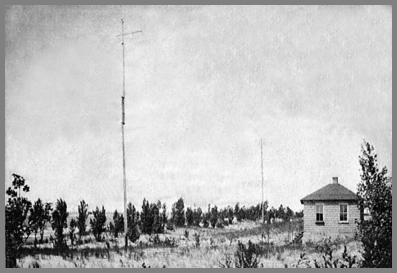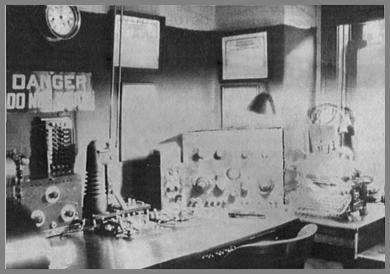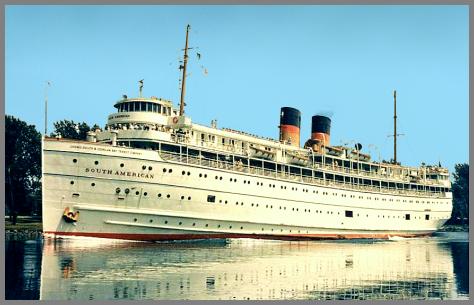
Great Lakes - Early CW
The SS South American was one of the last Great lakes ships to use CW - Photo courtesy of Tom Drake
Since the focus of this site is on the history of the 10 HF radiotelephone stations that served the Great Lakes and the inland rivers system the subject of early CW operation will not be covered in detail. Therefore, the emphasis of this page will be on presenting links to information at other sites and showing information which is otherwise not likely to be found on the Internet.
CW LINKS:
The very extensive Early Radio History site provides some information about the beginnings and early use of CW on the Great Lakes. If there are conflicts between information on this page and information on the Early Radio History Site the latter is more likely to be correct. The following pages on that site may be of interest to those interested in this aspect of marine radio history: This site has an excellent built-in search engine and entering "Great Lakes" in it will produce a cornucopia of information.
The Early Radio History page http://earlyradiohistory.us/1903clrk.htm and the book "Tower in Babel, Volume 1", by Erik Barnouw indicate perhaps the earliest beginnings of Great Lakes wireless pioneered by Thomas E. Clark. He began experiments in the Detroit area in 1899 and soon formed Clark Wireless and equipped the Garland, Sappho and Promise Steamers. By 1903 his company was called the Thomas E. Clark Wireless Telegraph and Telephone Co. and began experiments with voice transmission. He built transmitters in a number of port cities on the lakes, equipped more steamers and in 1906 broadcast election returns to them. The Early Radio history article has three pictures of the Clark Wireless installation in Detroit. By 1909 Clark had 7 US stations and one Canadian station operating and two more US stations under construction - all of these in the Great Lakes area. However, Clark Wireless was forced out of business by (and/or sold to) United Wireless Telegraph Company. Information is needed about the time and circumstances of the demise or (sale to United) of the Clark company.
These words from the book, "Empire of the Air," by Tom Lewis may explain why Clark could not compete with United: "The reason for its success (United's) may not be attributed to superiority of the system, however; United Wireless rarely charged for equipment or the messages it sent. Instead it depended of ever-expanding stock sales to keep it afloat." The 1909 station list shows United with 19 stations on the Great Lakes, and the Lewis book indicates that: "At its apex in 1910 United Wireless boasted 70 stations in communication with 400 ships sailing on the Atlantic Ocean and Great Lakes, far more than its competitors." Some sources indicate that Thomas Clark alerted the authorities to the United Wireless scheme, and on June 15, 1910 the government raided the company's offices in NY. Subsequent investigation found the company to be insolvent - the principle officers had siphoned off much of the money received from the sale of stock. Five company officers went to prison as a result.
A 15 page article describing RMCA's 1932 radiotelegraph operations. Mostly High-Seas, but includes 4 Great Lakes stations.
Another article http://earlyradiohistory.us/1907yht.htm details the 1907 use of wireless telephony to report on the progress of a yacht race from the radio equipped yacht Thelma.
Commercial
CW Operation Begins on the Great Lakes: http://earlyradiohistory.us/1909uwgl.htm
Early Radio Station Lists Issued by the U.S.
Government: http://earlyradiohistory.us/statlist.htm Several early station lists here including
The second link above is to a page which contains links to several early station lists. Here's my list of the 1928 lakes and rivers radiotelegraph stations - extracted from one of these nationwide lists.
Society of Wireless Pioneers, Inc. (SOWP)
The Society of Wireless Pioneers Publications Page.
The Internet Archive DLARC has preserved the newsletters of SOWP and 131 items are found by a Society of Wireless Pioneers DLARC search.
This Sparks Journal is a Historical Edition - Early Days Wireless on the Great Lakes. It's filled with Great Lakes articles.
See pages 25 and 25 of this Sparks Journal for two Great Lakes stories.
See page 4 of this Sparks Journal for a Great Lakes Coast Guard story.
See pages 24 and 25 of this Sparks Journal for two stories about dangerous weather on theGreat Lakes.
See pages 7-9 of this World Wireless Beacon for an article about Chicago Station WGO in the 1930s.
See pages 11 and 12 of this Ports O' Call for an article about a 1916-1921 Great Lakes operator's experiences.
These two links and the two pictures come from the SOWP Sparks Journal, Volume 7, No. 1, October 1984 - Great Lakes Edition - Used with permission. Here's their list of 1910 Callsigns. And their list of 1915-23 Callsigns.
 Early
CW Station WGH - Grand Haven, MI - Photo by |
 WTK installed in
Room 1070 of the Hotel Cleveland |
|---|---|
MORE LINKS
Here's a photo of another Grand Haven station.
These newspaper quotes (1909 and 1911-12) provide information on the early use of wireless on the Great Lakes. This information is from issues of The Detroit Marine Historian, the Journal of the Marine Historical Society of Detroit , and are used with its permission.
This NY Times had many articles about United Wireless Telegraph Co. in the 1907 to 1913 time period.
.One of the early (1906) CW stations on the lakes was one owned by Marconi and located in the Elberta Frankfort, MI area. It was installed for the Ann Arbor RR to provide communication with its car ferrys on Lake Michigan. It initially used the call FK which later became WFK.
.In 1911 the Marconi Co. sued the United for patent infringement. The Marconi case was very strong, and the then-bankrupt United was in no condition to wage a long court battle. In 1912, the lawsuit was decided in Marconi's favor, and it resulted in the merger of the two companies. Marconi acquired United's 70 land stations and over 500 ship-board installations. It was the primary communications provider to Great Lakes shipping until after WW1.
.In 1919 the government assisted by GE engineered the formation of RCA to take over the American interests of the Marconi Company. At its inception GE owned at least 80% of the stock in the new company with the Marconi owning the remainder. The new RCA was initially a communications company, though broadcasting and the manufacturing of tubes and broadcast equipment soon over-shadowed the communications operations. According to George C. Oslin's book The Story of Telecommunications RCA's Radiomarine Corporation of America was formed in 1927. It would be one of the prime providers of marine communications equipment and services for more than 40 years.
.A 1947 WLC Article received with other WLC documents was written by one of the founders of the station and has considerable information about the early years of the station and Great Lakes CW in general. The CW operation of WLC started in 1922. The station has also been known as WHT and WCAF.
.This FCC website page documents the operation of the Department of Commerce, Bureau of Navigation and later Radio Division from January 1915 to June 1932. (The FCC did not come into existence until 1934.) There is a bulletin for each month and each bulletin listed new stations and alterations to existing coast and ship stations often listing call letters. SOME EXAMPLES: The January 1915 Bulletin gives a long list of ship stations under the Change to Existing category. Radio Service Bulletin, April 1, 1924, No 84 shows Marine Weather bing transmitted by WTK Cleveland 706 meters and by WHT Rogers, MI on 600 and 706 meters and lists Great Lakes Ships that have been equipped with Vacuum tube receivers by RCA Radio Marine. The May 1, 1924 Bulletin (No. 85) lists the Great Lake ships that are operated by RCA Marine. Radio Service Bulletin, June 1, 1925 (FCC) states that a new license was granted to WMI Cleveland for operation of 600 and 875 meters. The owner was Great Lakes Radio Telegraph Compamy providing continuous Service. This same bulletin states that starting July 15, 1925 that 300, 600, and 706 meters will no longer be used by ship and land stations in the Great Lakes. In place, 715 and 875 meters will be used.
Many thanks to the Mid-Atlantic Antique Radio Club which graciously granted us permission to copy and display their article "Wireless on the Great Lakes - Recollections by Levon R. McDonald" which was printed in the October 2006 issue of their publication Radio Age. The link is to images of the article's four pages. MAARC Great Lakes Wireless Article .
Here's a copy of the 1924-27 "Commercial and Government Radio Stations of the United States" publication on-line.
FCC's early radio history page: https://www.fcc.gov/media/radio/radio-history-documents
Some ship owner managed their own systems. However, many owners contracted wireless service from either Marconi or RCA Radiomarine (RMCA). The service supplied the hardware, provided the licensing, and often provided the operators. Licensing required a specification of the hardware. Any change in wireless hardware or wireless service required an update to the license and these changes were handled by Marconi or RMCA. If a wireless station charged for this service, then the charges were part of the license. All radio calls were published by the international bureau at Berne and were brought up to date on any change.
Around 1939 the adoption of radio telephone on Great Lakes made the Morse operator optional on the freighters. The Morse operator was extra cost and did not satisfy the need for rapid communications between ships in river channels, etc. The WW2 Navy restrictions on any unnecessary ship radio telegraph traffic resulted in a vast decrease in traffic and thus resulted in the demise of many radio telegraph shore stations. This can be clearly seen on my FCC Timeline page.
CW Equipment:
The widespread use of vacuum tube electronics did not start until the early 1920s. Prior to that time, spark gap and alternators were the transmitters. Coherers and crystal sets were the receivers. With no amplification at the receiver, the transmitters were required to operate at high power levels. All use of spark transmitters were prohibited for US licensees after Jan. 1, 1940.
120 Volt DC was the main power supply on the ships. Large motor generator units were used to increase the voltage to acceptable levels to operate the tubes in the transmitter. The receivers B+ was connected directly to ship's 120 Volt supply.
After the spark era the 500 KHz CW equipment was really modulated CW (MCW). That is a 400 Hertz AM signal that was turned on and off. The transmitter (500 watts) had a VFO and the frequency was determined by zero beating with the super regenerative receiver. A typical receiver had 4 bands and covered from about 10KHz to about 600 KHz.
Around 1918? (seems too early) the
distress signal was changed to key down for 4 seconds, key up for 1
second, etc for around a minute
to trigger automatic alarm systems. If a ship was equipped
with an automatic alarm receiver, then 1 operator for cargo and 2
operators for passenger were required. However, the wireless
operators had to monitor traffic lists, sleep near equipment,
etc. A special clock was required in the radio room
to assist the wireless operator with the timing required to send the
distress signal. The clock also showed the Morse and the
voice quiet times.
On the ocean, 2182 receivers
require 2 tones to activate the receiver. The purpose is to
keep receiver quiet except for emergency situations.
Otherwise, the receiver picks up 2182 communications from all over the
world. It is equivalent to turning on an AM receiver night
and hearing pure interference from several stations on the same
frequency.
Here's a 1942 ad for a Scott marine receiver designed to have very low local oscillator radiation to thwart the detection of the ship via the enemy's use of radio direction finding gear. Ocean going ships got the priority for these receivers, but some were probably used on Great lakes vessels later on.
Miscellaneous
The 1935
"Radio Operator's Manual" by RCA shows the following RCA CW
stations and their frequencies on the Great Lakes: 161
KHz WBL Buffalo, NY - 167
kHz WGO Chicago, IL - WRL
Duluth, MN - 177
KHz WBL Buffalo, NY - 177
KHz WCY
West Dover (Cleveland), OH
410 KHz (Distress frequency), 425, 3106, 3120,
4140, 4790, 6330, 6210, 11205 KHz All
Stations
Here's the story of Martin Williams who managed all RCA regional operations from WGO - Chicago
World Radio History has preserved several of the RCA Employee Newsletters. Here are two from 1930: RMCA Great Lakes employee news This 1930 article states that WAA was under construction in Detour, MI which is on the upper peninsula at the head of Lake Huron. This is the only mention that I have ever seen of this station.
Here's a 1946 RCA Calendar showing both WCY and WBL in service at that time.
Some photos of WCY at George Thompson's memorial site
The Telegraph Office has a Wireless Photo Gallery page. Unfortunately, all of the historical content that this site once hosted has been lost as nothing remains except the index page. Even the WayBack Machine has nothing. So sad.
In the 1941 Alpena, MI Telephone Directory I recently discovered a listing for a "Michigan Wireless Tel Co. Park Place ---------675" Its call letters were WGI. I lived in Alpena until I was 9 and remember the tower for what was likely this station as there were no broadcast stations in Alpena at that time. However, it could have been for police radio. Early in WW2 I remember someone telling my dad that the feds (Navy or FCC?) shut it down for the war duration for security reasons. A little more about the station's purpose and the shutdown is on page 10 here and about the station's finances on page 21/27 here.
W8TP who served as an operator on the Georgian Bay line's SS North American, SS South American and the SS Alabama prior to WW2 reported that WGO was on top of the Congress Hotel in Chicago and one of the Operators was ??? McCartney.
Non-RCA Station WLC was also
operating on CW in 1935 - Also WFK Frankfort,
MI (Ann Arbor RR car ferries in Lake
Michigan).
In
1940 the GL calling frequency was changed from 410 to 500 kHz.
Here's a 1912 Map of Great Lakes Canadian Radio-Telegraph Stations
